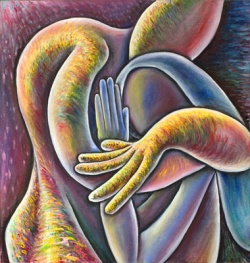Kam
| Part of a series on Sikh Beliefs |
| Sikhism |
|
2. Three Pillars |
|
3. Five Evils |
|
4. Five Virtues |
KAM (Gurmukhi: ਕਾਮ) meaning deep desire, uncontrolled longing, concupiscence, lust, sensuality or lasciviousness is counted among the five cardinal sins or sinful propensities.
In common usage, the term stands for excessive passion for sexual pleasure and it is in this sense that it is considered an evil in Sikhism. The Guru state clearly "Engrossed in lust and anger, people wander through reincarnation over and over again" (SGGS p 50)
In Brahmanical literature kam is not always disdained. Kam as Kamadeva is a god in the Hindu pantheon comparable to Eros of Greek mythology and Cupid of the Romans, and is as such not contradictory to spiritual life.
Kam (gratification of desire) is in Hinduism one of the four objectives (purusarthas) of human life, the other three being artha (acquirement of wealth), dharma (discharge of duty), and moksa (final emancipation). Jainism and Buddhism, which arose as protest movements against Brahmanical ritualism and superstition, however looked upon kam with horror.
For munis and sramanas of Jainism and Buddhism and for yogis of the Sankhya school, kam was to be deliberately suppressed to achieve ultimate release. As a result, they preached celibacy and asceticism.
The Gurus rejected Brahmanical superstition as well as self-mortifying austerities. Yet they recognized the four purusarthas, referred to in gurbani as char padaraths or the four human pursuits. However, in Sikhism kam is not unrestricted gratification of carnal desires, but an impulse which needs to be kept under check like other impulses and passions. Unrestrained propensity towards kam, especially sexual relationship outside the marital bond, is condemned in the strongest terms in Sikh codes of conduct as well as in the Scripture. It is a destructive evil and a deadly sin.
Message of Gurbani
- Main article: SGGS on lust
To quote Guru Arjan, Nanak V: “O Kam, thou landest people in hell and makest them wander through many births, enticest all minds, swayest all the three worlds and undoest one's meditation, austerities and restraint. The pleasure is ephemeral and thou afflictest high and low alike" (GG, 1358).
Guru Tegh Bahadur Nanak IX, says: "In the sinning heart reigns kam and the fickle mind breaks out of control. Kam casts its noose even upon yogis, jangams and sannyasis. Only those imbued with God's Name (fall not a prey to it) and are able to go across the ocean of existence" (GG, 1186).
Bhai Gurdas describes an ideal Sikh as one who is loyal to his wife and "regards all other women as mothers, sisters and daughters" (Varan, XXIX. 11).
Guru Gobind Singh also said: "Love your own wedded wife ever so more, but do not go to another woman's bed even in a dream." Sikh codes of conduct strictly prohibit extramarital relations.
While prescribing self-control and restraint and not total annihilation of kam, the Gurus suggested two ways of channelizing and sublimating it. On the one hand, they pronounced grihastha or married life to be the ideal one, and, on the other laid down love of God and absorption in His Name as the essential principle of spiritual discipline.
Says Guru Gobind Singh "Hear ye all, I proclaim here the truth: only they who love God find Him." The image of a devotee most common in Sikh Scripture is one of a wife deeply in love with her "kant" or husband presently separated from him, and waiting, craving, praying for a reunion with him. Such fervent devotion cannot but bridle the wayward passion in man. According to Guru Arjan, a person who has cultivated the love of the Lord’s feet would desire neither kingship, nor worldly power, nor even mukti or liberation (GG 534).
In the following Shabad, the Guru explains in very clear terms that lust and wrath will eat away the body away just as borax dissolves and eats away pure gold. So the pure God-given body will be wasted away if one allows the mind to be overcome by rage, anger or lust. One is given a very clear warning to guard oneself from these negative emotions.
| ਕਾਮ ਕਰੋਧ ਕਾਇਆ ਕਉ ਗਾਲੈ ॥ ਜਿਉ ਕੰਚਨ ਸੋਹਾਗਾ ਢਾਲੈ ॥ Kĝm kroḝẖ kĝiĝ kao gĝlai. Jio kancẖan sohĝgĝ dẖĝlai. |
| sggs page 932 |
See Also
BIBLIOGRAPHY
- 1. Sabadarth Sri Guru Granth Sahib. Amritsar, 1964
- 2. Sher Singh, The Philosophy of Sikhism. Lahore, 1944
- 3. Avtar Singh, Ethics of the Sikhs. Patiala, 1970
- 4. Nripinder Singh, The Sikh Moral Tradition. Delhi, 1990
Above adapted from article By L. M. Joshi
| Five Evils |
|
1.Kam (Lust) 2.Krodh (Rage) 3. Lobh (Greed) 4. Moh (Attachment) 5. Ahankar (Ego) |
| Gurus: | Nanak Dev | Guru Angad | Amar Das | Ram Das | Guru Arjan | Har Gobind | Har Rai | Har Krishan | Tegh Bahadur | Gobind Singh | Guru Granth Sahib | Sikh Bhagats |
| Philosophy: | Sikh Beliefs | Simran | Sewa | Beliefs and Principles | Underlying Values | Prohibitions | Technique and Methods | Other observations | Technique and Methods |
| Practices: | Ardas | Amrit Sanskar | Chardi Kala | Dasvandh | Five Ks | Kirat Karni | Kirtan | Langar | Naam Japna | Simran | Three Pillars | Vand Chakna | Five Evils | Five Virtues |
| Scripture: | Guru Granth Sahib | Sikh Scripture | Dasam Granth | Ek Onkar | Waheguru | Bani | Mool Mantar | Japji Sahib | Jaap Sahib | Chaupai | Anand Sahib | Tav-Prasad Savaiye | Rehras | Sukhmani |
| More: | History | Gurdwaras | Harmandir Sahib | Khalsa | Khanda | Names | Places | News | Satguru | Sikhs | Bhagat Farid | Bhagat Kabir | Websites | Biographical | Terms |


